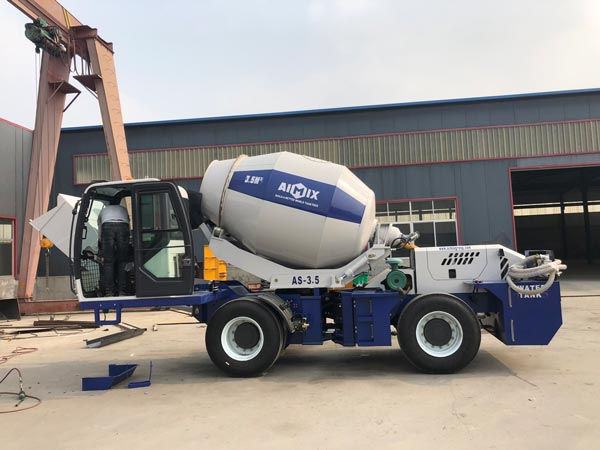Understanding Different Concrete Mixer Specifications
- wangamy263
- Apr 2
- 3 min read
Concrete mixers are essential in construction. They come in various types, each with unique specifications. Understanding these specifications can help customers choose the right mixer for their needs. This article explores the specifications of self loading concrete mixers, mobile concrete mixers, hydraulic concrete mixers, and portable concrete mixers.
Self Loading Concrete Mixers
Self loading concrete mixers automate the loading process. Key specifications include drum capacity, mixing speed, and automation features. Drum capacity typically ranges from 1 to 4 cubic meters.
Mixing speed varies, but most models offer adjustable speeds. Advanced automation features ensure precise material measurement. The concrete self loading mixer reduces labor costs and enhance efficiency. Understanding these specifications helps you choose the right model for large projects.

Mobile Concrete Mixers
Mobile concrete mixers are known for their flexibility. Important specifications include drum size, mobility features, and control options. Drum sizes range from 2 to 12 cubic meters.
Mobility features include GPS tracking and remote control capabilities. Enhanced suspension systems ensure stability during transport. Control options allow precise adjustments. Mobile mixers are ideal for projects requiring frequent movement. Knowing these specifications helps you select a suitable mixer.
Hydraulic Concrete Mixers
Hydraulic concrete mixers offer improved efficiency. Key specifications include hydraulic system pressure, drum capacity, and safety features. Hydraulic system pressure is crucial for consistent mixing.
Drum capacity ranges from 1 to 8 cubic meters. Safety features include pressure release systems and emergency shut-off mechanisms. Hydraulic mixers reduce maintenance needs and ensure smooth operation. Understanding these specifications ensures you choose a reliable mixer for your needs.
Portable Concrete Mixers
Portable concrete mixers focus on ease of use. Important specifications include weight, drum capacity, and motor efficiency. Lightweight materials enhance portability.
Drum capacity typically ranges from 0.5 to 2 cubic meters. Efficient motors reduce energy consumption. Advanced mixing blades ensure a consistent mix. Portable mixers are perfect for small projects and DIY tasks. Knowing these specifications helps you select the right portable concrete mixer for convenient use.
Drum Capacity
Drum capacity is a crucial specification for all mixer types. It determines the amount of concrete the mixer can handle. Larger capacities are suitable for big projects.
Smaller capacities are ideal for minor tasks. Self loading mixers usually have larger capacities. Portable mixers often have smaller drums. Understanding drum capacity helps you choose a mixer that meets your project's requirements.

Mixing Speed
Mixing speed affects the consistency of the concrete. Adjustable speeds allow control over the mixing process. Faster speeds are suitable for quick tasks.
Slower speeds ensure thorough mixing. Self loading mixers typically offer adjustable speeds. Hydraulic mixers feature precise pressure controls. Knowing mixing speed specifications helps you select a mixer that provides the desired consistency.
Automation Features
Automation features enhance efficiency and precision. Self loading mixers have advanced sensors and controls. These features automate loading and mixing processes.
Mobile mixers may include GPS tracking and remote controls. Hydraulic mixers often incorporate automated pressure systems. Portable mixers feature easy-to-use controls. Understanding automation features helps you choose a mixer that simplifies operations.
Safety Features
Safety features protect operators and ensure safe operation. Self loading mixers include advanced safety sensors. Mobile mixers offer enhanced stability controls.
Hydraulic mixers have emergency shut-off mechanisms. Portable mixers come with safety locks. Understanding safety features helps you choose a small concrete mixer machine that prioritizes operator safety.
Mobility Features
Mobility features are essential for mixers that require movement. Mobile mixers include GPS tracking and remote controls. Enhanced suspension systems improve transport stability.
Portable mixers are lightweight and easy to move. Hydraulic mixers may have wheels for easy transport. Knowing mobility features helps you select a mixer that meets your movement needs.
Conclusion
Understanding different concrete mixer specifications is crucial for selecting the right mixer. Self loading mixers offer automation and efficiency. Mobile mixers provide flexibility with enhanced mobility features.
Hydraulic mixers ensure consistent mixing with advanced pressure controls. Portable mixers focus on ease of use and transportability. Key specifications include drum capacity, mixing speed, automation features, safety features, and mobility features.
Understanding these specifications helps customers choose a mixer that meets their project needs. Concrete mixer technology continues to evolve, offering new, valuable, and useful solutions for the construction industry.







Comments